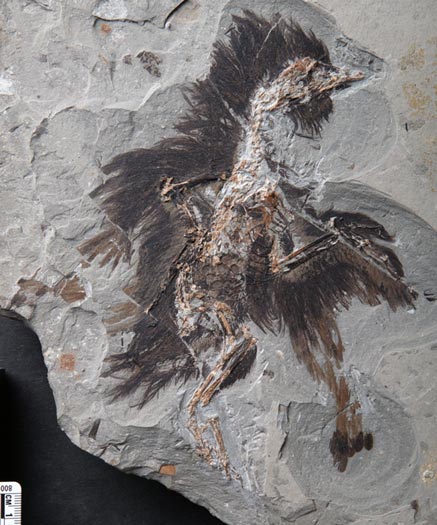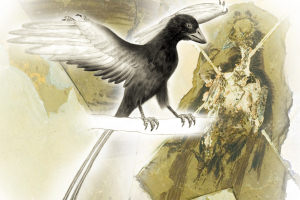Bird Melanosome Stories Flocking Together as New Research is Published
Keratin and Melanosomes Preserved in Eoconfuciusornis
A team of international scientists led by researchers from the Chinese Academy of Sciences in collaboration with colleagues from North Carolina State University and Linyi University (Shandong, China), have reported finding the oldest fossil evidence of beta-keratin and melanosome preservation in the feathers of a 130-million-year-old primitive bird from the famous Early Cretaceous Jehol Biota of north-eastern China.
Keratin and Melanosomes Preserved in Eoconfuciusornis
Writing in the journal “The Proceedings of the National Academy of Sciences (United States)”, this new study extends the time frame in which evidence of original organic molecules may be preserved and has provided new data on how to distinguish melanosome structures from similarly shaped microbes. This is the second article related to the melanosomes having been identified in ancient birds that Everything Dinosaur has published the week. The earlier article related to a bird fossil identified as a member of the Enantiornithes clade excavated from the Lower Cretaceous strata (Jiufotang Formation), that showed evidence of iridescence in its feathers.* It’s almost as if stories relating to melanosome structures in birds are flocking together!
The Lower Cretaceous rocks exposed in the Chinese provinces of Hebei and Liaoning have provided palaeontologists with a huge number of vertebrate fossils to study. The fine-grained strata, laid down in a lacustrine (lake environment), surrounding by active volcanoes provided ideal body fossil preservation conditions and many specimens have revealed exquisite details. One of the most important group of fossils associated with these deposits are the many different types of bird fossil that have been found. This new study was carried out on the fossilised remains of one such primitive bird, a specimen of Eoconfuciusornis.
Scanning Transmission Microscopy
Scanning transmission microscopy was undertaken to identify structures within the fossil and the surrounding matrix, chemical analysis including the use of antibodies that react to specific proteins, helped pinpoint the identity of the structures that had been found.
The Fossilised Remains of Eoconfuciusornis Used in the Research
Picture credit: Dr Xiaoli Wang (Linyi University)
For models and replicas of Chinese prehistoric animals including confuciusornithids: Dinosaur Models and Figures (PNSO).
What Sort of Bird was Eoconfuciusornis?
Eoconfuciusornis was a crow-sized member of the primitive bird group the confuciusornithids that thrived in China during the Early Cretaceous. It was one of the first birds to possess a pygostyle (the last five tail vertebrae fused together) and to have a keratinous beak lacking teeth, features found in all modern birds (Neornithes).
Previous studies had striven to prove that tiny, round or sausage-shaped structures preserved in association with fossilised remains were melanosomes, organelles found in animal cells that contains the light-absorbing pigment melanin responsible for colour and protection from harmful rays emitted from the sun.
However, although melanosome-like structures had been discovered in a number of specimens, there was an element of doubt as to the authenticity of the research findings. It was difficult to definitively proved that these structures were not just microbes that had become associated with the feathers during decomposition and fossilisation.
Studying Melanosomes
Mary Schweitzer, a leader in the field of identifying traces of organic materials from within the fossil record and a co-author of this research paper explained the problem:
“If these small bodies are melanosomes, they should be embedded in a keratinous matrix, since feathers contain beta-keratin. If we couldn’t find the keratin, then those structures could as easily be microbes, or a mix of microbes and melanosomes, in either case, predictions of dinosaur shading would not be accurate.”
The scientists used both scanning and transmission electron microscopy to map minute details of the feather’s surface and its internal structure. They also utilised immunogold tagging, a technique which involves gold, non-reactive particles being attached to antibodies that bind to particular proteins in order to make them visible in electron microscopy. This helped to show that the fine filaments within the feathers were keratin.
An Illustration of a Typical Confuciusornithid Bird of the Lower Cretaceous (Confuciusornis sanctus)
Picture credit: University of Manchester
Mapping Chemical Elements
Further tests were carried out, including one which involved the mapping of the presence of copper and sulphur in association with the feathers when viewed under high resolution. Sulphur was broadly distributed, reflecting its presence in both melanin molecules and keratin. However, the distribution of copper (only found in modern melanosomes and not part of keratin), was only observed in the fossil melanosome structures. The data produced supports the identity of melanosomes and indicates that these structures are not the result of contamination or microbial action.
Fellow author, Yanhong Pan (Chinese Academy of Sciences) stated:
“This study is the first to demonstrate evidence for both keratin and melanosomes, using structural, chemical and molecular methods. These methods have the potential to help us understand, on the molecular level, how and why feathers evolved in these lineages.”
If melanosomes can be positively identified within the fossil record and as the shape of melanosomes can provide an indication of animal colouration, then palaeontologists may be able to hypothesise with greater confidence the colouration of extinct animals including dinosaurs and primitive birds.
* To read Everything Dinosaur’s recently published article on the study of a member of the Enantiornithes clade that shows evidence of iridescence in preserved feathers: A Prehistoric Bird with Bling.
The scientific paper: “Molecular Evidence of Keratin and Melanosomes in Feathers of the Early Cretaceous Bird Eoconfuciusornis”, published in the Proceedings of the National Academy of Sciences (United States of America).
The Everything Dinosaur website: Everything Dinosaur.



